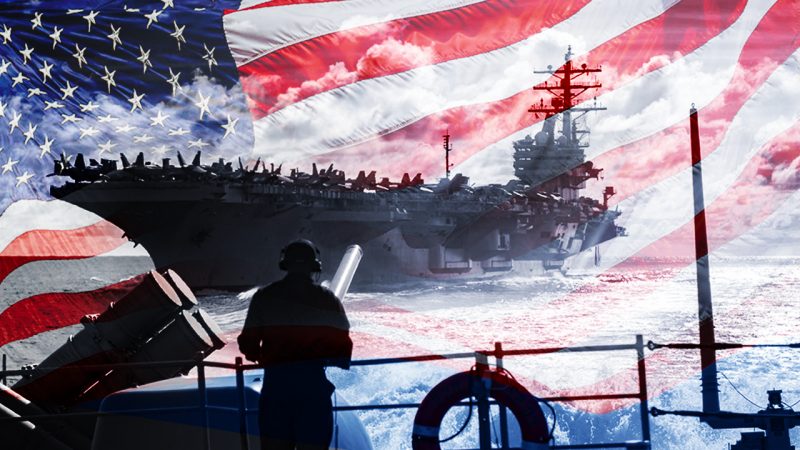The United States had entered the World War I with the pressures and demands of the Great Britain, on 6th April 1917 one month after the government change in Russia on March 3rd 1917. Russia withdrew from the war.
The German advance in Europe was brought to a halt by the United States’ involvement in the war. At this point, European dependence on Transatlantic, which still continues to this day, began. The US Navy consisted of 282 vessels on March 3, 1917- by November 1, 1918, near the end of the war, that number had reached 1,378, of which 373 were stationed in the European theatre.
During World War II, US Naval expansion accelerated faster and in much greater numbers. Two years after the start of WWII, the US sided with the Allies after the Japanese attack at Pearl Harbor on December 7, 1941. Between 1941 and 1945, the US managed to build eight battleships, 112 aircraft carriers of different tonnages (including the 82 escort carriers), 48 cruisers, 354 destroyers, and 203 submarines. Funds dedicated to the Navy accounted for the 1.5% of the entire US GDP of that time. Building such a large force in just four years showcased the might of American industry: such a navy could only be built in 20 years under normal circumstances. The United States took over the Pax Britannica’s chain of military bases during World War II, and after 1956, this led to a complete British withdrawal from the oceans in the east of Suez Canal. The two necessities of hegemony, military bases and a strong navy, were firmly established to a degree which was never seen in human history.
THE NAVY IS THE KEY TO AMERICAN HEGEMONY
During the Cold War, Washington maintained the strong Navy and a high operational tempo that was needed to ensure the control of all oceans and important maritime choke points under the strategies of Rimland/Soviet Containment and Mahanist naval domination. This navy was used as a deterrent force for the Washington Consensus. What did the strategist George Friedman, founder of Stratfor (a think tank known as the shadow organization of the CIA) have to say about this?: “The foundation of the American power is the oceans. Its domination over the oceans prevents other countries from attacking the United States but allows the United States to intervene when necessary and grants it control over international trade. Global trade is dependent on the oceans. Whoever controls the oceans, controls the global trade. And America’s mission here is to prevent the strengthening of any challengers who can threat our control over the oceans… In order to ensure the physical security of the United States, it is essential to maintain a full dominance over the world’s oceans and control the international trade system. Now, the US controls all the oceans. There is no power in history that has ever been able to do that. This control not only constitutes the basis of the US national security, but also the make up basis of the power to shape the international system. No one can go anywhere by the ocean, if the US does not allow them to do so. And at the end of the day, maintaining the control over the world’s oceans is the most important geopolitical mission for the United States.”
DEGRADING AMERICAN NAVAL POWER
However, these confident assessments by Friedman are now facing serious challenges. The situation today is much different than it was 30 years ago during the Cold War. The United States is no longer in a position to form a capable conventional Navy similar to the one that was built during the World Wars, and wouldn’t be able to even if a large-scale war between major powers took place today. Its ability to build a navy has declined considerably when compared to the conditions of the last century. As of today, the US Navy has 293 vessels (by comparison, China has 350). They only have 98 active ships in all the oceans combined, only some of which are operating in the European/Atlantic theatre: 60% of this navy is stationed in the Pacific operation area as a part of the Asian Pivot strategy against China and Russia.
There are many reasons for this downsizing. First, the navy shrunk quickly after their victory in the Cold War. They did this thinking that naval supremacy would remain in their hands forever, high on the euphoria of glory between 1989 and 2001. After September 11, 2001, they changed their strategy from defense to security. Thus, the downsizing continued. Many of the military dockyards were shut down. The US Navy, which had 594 ships back in 1987, has shrunk down to 290 ships during the Obama administration in 2012. During this period, the Navy experienced the biggest budget cut in its history, and even a draft law that would reduce the number of their aircraft carriers from 12 to 8 was proposed. That proposal caused a lot of waves in Washington. Despite Republican opposition, $472 billion were taken away as a defense cut from the 10-year budget, and shortly after that cut, an additional $412 billion were sequestrated from the ten-year defense budget. These cuts crippled the US Navy’s supply and operational activities. The budget cuts were so harsh that the Commander of the US Fleet Forces Command (formerly known as the Atlantic Fleet) Rear Admiral John Kirby criticized his own government to the Virginian Pilot newspaper in March 2013, by saying “Fleet Commanders Cannot Operate”.
FACING REALITY
In 2017, with the transition from the paradigm of Global War on Terror (GWOT) to the Global Power Competition (GPC), it became clear that the current Navy would not be enough to maintain the global order and police the world oceans. A program for 355 ships was launched over the next decade, and another program for 500 ships was recently launched. A budget increase of $147 billion and a program for the construction of 80 ships by the end of the next five years was going to be proposed if Trump had managed to stay in power. But it still remains unclear when these programs will actually be able to take place given the dire situation of crippling national debt, economic crisis, and the broken social contract in American society.
THE TIDES HAVE TURNED
A force that could create a well-balanced power distribution between the main missions of the US Navy, which are power projection, sea control and the protection of sea lanes of communications, is not possible taking the current Russian and Chinese Naval powers into account. Since a numerically large Soviet Navy and the social coherence against the Soviet threat were both present in the United States during the Cold War, there were no budgetary or administrative problems that could affect the development of the Navy. The US Naval program was called the ‘600-Ship Navy’ at the end of the 1980s. Now, they cannot even commission 300 ships. On the other hand, Chinese and Russian naval powers are very serious rivals in specific areas. The Russian and Chinese submarine fleets, hypersonic missile systems and the DF-21 ballistic missiles, which are known as simply long-range aircraft carrier killers, surely would not let the US Navy get closer to shores of Asia in the Pacific, or near the North Sea/Arctic coasts so easily and freely. This is a first-time observation in recent human history.
THE DAMAGE OBAMA DID TO THE NAVY
The damage done to the navy during the Obama administration created a serious decline in combat readiness due to the increase in the number of ship accidents in record occasions; long delays in new ship commissioning as well as planned maintenance and urgent repairs and dismissed ship and shore commanders for inadequate service, lack of discipline and corruption. This situation has yet to be fixed. For example, when there were numerous submarine and destroyer tenders and floating drydocks at the disposal of the US Navy during the Cold War, there is not a single one commissioned today. While the repair time of a destroyer that took a heavy torpedo damage would only take 9 months during World War II, two Arleigh Burke-class destroyers which had collided with merchant ships in the Pacific back in 2017 took 2.5 years to repair. The issues of repair and maintenance are enough to cause some serious problems for US navy ships serving in remote oceans or in unexpected operation areas, especially in the event of a war. There is also a serious shortage in drydocks for submarines and aircraft carriers in the United States today, let alone the floating drydocks. In both World Wars, the United States confiscated the ships of the merchant fleet and commissioned them in the navy. The Jones Act of 1920 is a tool that protects the US cabotage rights and does not allow foreign-flagged ships on the coastal trade. Despite this, the US merchant fleet today is extremely insufficient. Attacks on the Jones Act increased during the Obama administration. The US Navy is also very insufficient in the number of escort ships available for the protection of maritime transportation in the event of a major war. The number of warships which are capable of crossing the Atlantic without refueling is limited. Most of the surface combatants need to be supported with either tankers or fleet support ships which are very limited as well. Furthermore, merchant ships do not have surface or air self-defense systems like the ones in both world wars.
THE SITUATION IS REFLECTED IN THE STRATEGIC DOCUMENTS
The US Navy is aware of the restrictive situation they are in. They published a document called “A Cooperative Strategy for 21st Century Seapower (CS-21)” in 2007, and three years later, they published a concept document called NOC 2010 (Naval Operations Concept), on how to implement the strategy that was published. For the first time in US history, the Navy, Marine Corps and the Coast Guard Commands, which make up the entirety of American sea power, have gathered together to form an integrated naval strategy. With this strategy, the shrinking US naval force tried to adopt a new approach to combine the national power elements with the capabilities of the allied countries. The document also described the global maritime environment from the perspective of American national security. Interestingly, China was never mentioned even once in the document. The document stated that “The 21st-century naval strategy will be used effectively, proportionally against the attackers, with the ability to retaliate by conventional, irregular and nuclear power.” With this statement, the main purpose of American naval power was announced to the world and its adversaries were subtly threatened. The goal of maintaining US naval power indefinitely and globally was also announced. According to this strategy, US naval forces could be deployed to any critical region and or areas of interest for the protection of continental United States and the pursuit and furtherance of interests in the oceans.
The document also identified the preservation of global architecture which are composed of independent commercial organizations, financial instruments, information systems and the legal and administrative networks to sustain dollar based economic order as a strategic outcome. In short, the entire document was a boisterous challenge.
THE AMERICAN NAVY GETS IN TOUCH WITH REALITY
The second edition of the CS-21 document was released on March 13, 2015, with the signature of Obama’s Secretary of the Navy. Over the time, China had changed its posture in the South China Sea and Russia united with Crimea against Washington’s wishes. US hegemony seemed to be grinding to a halt. First, the document was a message to the Congress, the Senate, the American bureaucracy, and to the people at home, as much as it was a message for those outside. For the first time, an American-made document needed to explain the reasons for the existence of its navy with strong emphasis, largely as a result of damage done in the Obama era. Second, the need for joint and allied coalition operations, or simply cooperation with allies and partners, was emphasized. Third, they paid attention to China and Russia for the first time since the end of the Cold War. The fourth was new tactics, doctrines, and technologies being announced, especially in cyberwarfare. The fifth was the Arctic Ocean being studied for the first time as a separate chapter.
2020: THE SITUATION IS SERIOUS AND ALARMING
The rise of Chinese and Russian naval powers over the last 5 years has complicated what was written in the strategy documents of 2015. The US published the third edition of the CS-21 document on December 17, 2020 with the title ‘Advantage at Sea’ and the signature of the Secretary of the Navy. The main purpose of this document, which was published for the first time since 2017, when the G. Walker Bush-era paradigm of Global War on Terror (GWOT) transitioned to the Great Power Competition (GPC), is to prioritize Chinese and Russian naval threats in order to increase the budgets for the Navy, the Coast Guard and the Marine Corps. Because the US Navy knows that it can no longer be the ruler of the oceans and has now lost its superiority at sea, with its current budget, command structure, and resource allocations. They simply prefer to express this indirectly rather than openly admitting to the public and Capitol Hill. Emphasizing that modernization is the key to rule the seas, the report warns that in the next decade, the US Navy will be ineffective in protecting the national interests of the US in the oceans. The report also recommends the development of the alliance systems and the coalition partnerships in order to tackle this situation.
THE SUN RISES IN THE EAST
2020 is over. The Biden administration will swear into office on January 20, but the naval force he will take over still bears the scars of the damage done during the Obama administration. With the technological advancements that have been made in recent years, it is now a fact more than an intellectual assessment that the US Navy will be in a difficult situation to face Russian and Chinese naval forces in a large-scale conventional conflict. The United States, which had enforced its global hegemony after 1945 after winning World War II in the Pacific, could not predict that the Soviets would collapse by 1989. They also could not predict that the Chinese and Russian naval forces would rise so quickly after the Cold War. The US Navy can no longer rule the waves in the oceans. I sincerely would like those that think that pandering to Atlantic interests is the only way to get elected in Turkey, to realize these strategic facts. As Galileo said, despite the ideological dogma which asserts the opposite, “yet, the earth moves and yet the sun rises from the east”: Ex Oriente Lux.









Leave a Reply